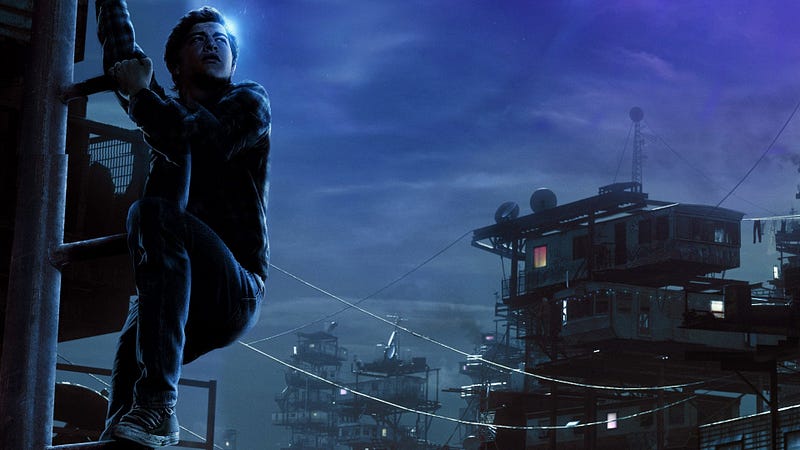# Exploring Virtual Realities: Lessons from Ready Player One
Written on
Chapter 1: The Dilemma of Technology and Humanity
The film Ready Player One addresses contemporary challenges surrounding human nature and its relationship with technology, narratives, and cultural shifts. The OASIS, a virtual reality game central to the film's plot, significantly impacts the mental health and social interactions of its characters, leading to serious repercussions for human connections.
Although fictional, Ready Player One serves as a cautionary tale regarding the pitfalls of misusing advanced technology. This examination is particularly relevant given the rapid growth and emerging market for virtual reality entertainment in recent years.
In 2020, fans of pop culture learned about plans for a sequel, Ready Player Two, which would follow Steven Spielberg's original Ready Player One (2018). The success of the first film could pave the way for a new series of adventure films, reminiscent of how Spielberg’s adaptation of Michael Crichton’s Jurassic Park created a lasting franchise.
Spielberg's storytelling prowess encompasses a wide range of themes, from those addressing oppression and discrimination to those that celebrate imagination and adventure. Ready Player One exemplifies this blend of various narrative elements. It combines an epic quest to solve riddles within the VR game, along with a menacing antagonist, Nolan Sorrento, who seeks to undermine the protagonist, Wade Owen, and his group of friends. Sorrento's ruthless ambition reflects a common archetype of the villain motivated by profit, showcasing the darker side of the OASIS experience.
Understanding the OASIS is crucial for grasping the film's stakes. It transcends a mere video game; it envelops players in a fully immersive experience akin to a 4D film, where sensory effects enhance the viewer's physical presence. Players often don full-body suits fitted with sensors, allowing them to feel both pleasure and pain tied to their actions in the OASIS, creating an intricate interplay between the virtual and real worlds. Players who cannot afford upgrades face real-life consequences, emphasizing the high stakes of this virtual domain.

Image via TheMovieDB.org
Modern philosophers critique the impact of such powerful virtual realities as the OASIS. In A Mind at Peace, authors Christopher Blum and Joshua Hochschild advocate for a return to temperance in engaging with modern technology. Their warnings resonate with the allure of the OASIS and the transformations it inflicts on individuals. They suggest a cautious approach to new technologies, emphasizing their profound effects on human thought and behavior:
“It is our sight dominance that makes the digital age at once so promising and so logical a development of human culture, and also so dangerous. We are apt to be drawn to the light of a screen, whether it be a television or a smartphone, and captivated by its colors. More dangerously — and perhaps diabolically — we are apt to be drawn into different worlds altogether, virtual worlds created by and in light. If we are to navigate this digital era, we must learn how to discern true from false seeing.”
The OASIS serves as an enticing example of these “virtual worlds created in and by light.” Its visual appeal, combined with sensory engagement, makes it easy for individuals to become engrossed, blurring the lines between reality and simulation. Blum and Hochschild argue that this can lead to an addiction-like relationship with mediated experiences.
Ready Player One opens with Wade navigating his cluttered home and neighborhood, where most residents engage with the OASIS rather than connecting with one another. Tensions arise when Wade's aunt's boyfriend becomes angry over his use of the gaming equipment. Such irrational emotions reflect the toxic environment fostered by the OASIS, which envelops Wade and his community. While many players aim for monetary gain, Wade approaches the game as a puzzle to unravel, hoping to understand Halliday, the game's creator, who shares his passion for pop culture.
According to the hylomorphic perspective in Thomistic philosophy, as embraced by Blum and Hochschild, a game impacts not only the player's body but also their very essence. Any form of communication or gaming can reach deep into our being, and VR experiences like OASIS amplify this effect.
Chapter 2: The Experience Machine and Its Implications
Philosopher Robert Nozick's thought experiment, known as "the experience machine," presents a scenario where individuals can plug into a device that simulates any desired experience. However, once connected, they cannot disconnect, leading to a troubling realization: reality diverges significantly from the simulation. Users risk becoming mere instruments of their own desires.
This concern echoes the fears expressed in A Mind at Peace, which warns that destructive thoughts can arise from unchecked imagination and temptation. This notion applies to both Nozick's experiment and the OASIS, where users may be able to choose when to exit but are still subject to the game's demands, which can bring about both pleasure and pain. Blum and Hochschild express alarm at the potential for such experiences to lead to hedonism and emotional manipulation.
The wisdom of Halliday, the deceased creator whom Wade confronts at the film's climax, encourages players to seek genuine experiences outside the OASIS. He would likely disapprove of the chaos and indulgence his creation has fostered.
In summary, Ready Player One serves as a critique of the potential dangers associated with contemporary technology designed to captivate us and enhance user experience. Observers like Blum, Hochschild, and Nozick remind us that authentic love and the true good of others are best realized in the real world, not in synthetic environments. Ultimately, our true happiness lies in genuine relationships, not in artificial simulations.

Subscribe to Storius Direct to receive articles like this to your inbox. Subscribe to Storius Digest for a weekly digest with links. Elsewhere: LinkedIn • Facebook • Instagram • Twitter • Flipboard